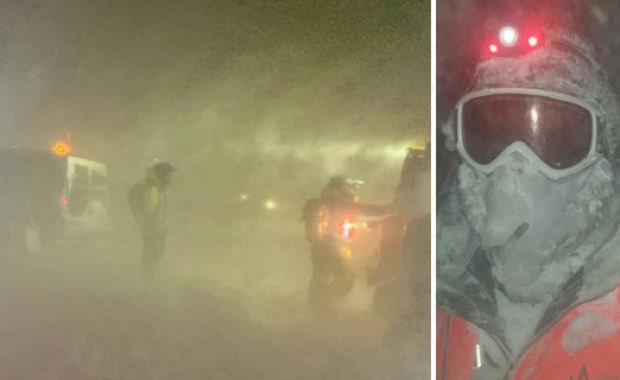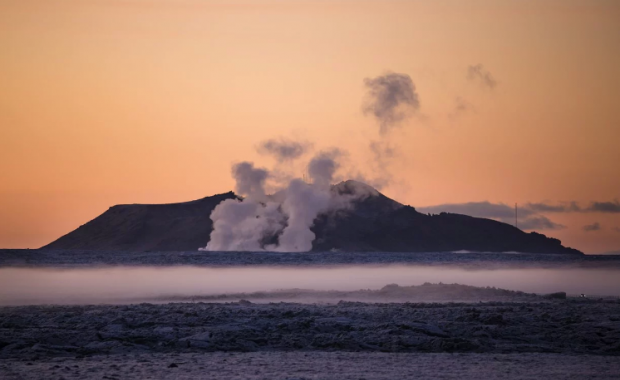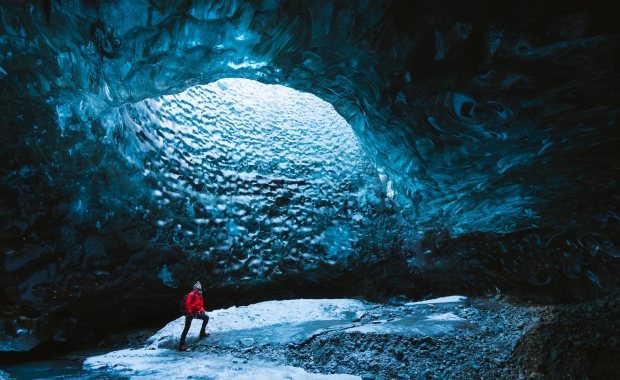During the 1973 eruption in Heimaey, Westman Islands, hundreds of homes were buried under massive amounts of lava and ash. In May of last year, the house at Gerðisbraut 10 emerged from the ash and pumice. The house belonged to Gerður Sigurðardóttir and her late husband Guðni Ólafsson, who had built it in 1971. After being submerged under ash for over forty years, the house bears silent witness to the disaster that struck the town in 1973: a towel still hangs on a hook by the bathroom sink, and the furniture is still in place, although damaged by the ash. Soon after the Heimaey eruption began, houses closest to the rift disappeared under lava flows and tephra fall. Some days later, the prevailing wind direction changed, moving to the west. This resulted in ash falls over the rest of the town that caused extensive damage to property. Around four hundred homes disappeared under lava and thick layers of ash.
In 2005 the Vestmannaeyjar town council agreed to take part in a project that involved excavating ten houses that had been buried under lava since 1973, and a construction of a visitors’ centre where people can view the houses and learn more about this extraordinary event. The project was named Pompei of the North and now four houses have already been unearthed.
It was as though the earth had been zipped open
The house where time stood still
The house at Gerðisbraut 10 will be the centre’s main attraction. Former owner, Sigurðardóttir, was allowed inside her old home shortly after the house was excavated. Gerður describes the experience as an emotional one in an interview with Fréttablaðið newspaper in October 2012.
“One becomes emotional seeing one´s home abandoned after all this time. I missed not having my late husband with me. But I’m happy that I allowed the excavation because I was right all this time; my house is still standing.”
She also remembers the night of the eruption very vividly. “When I pulled back the curtains, I could see this extremely large fire pillar. I called my husband and we saw a long, gaping fissure only four hundred metres away from us. It was as though the earth had been zipped open.”
![src=http://icelandmag.com/sites/default/files/styles/article_body_image/public/thumbnails/imagep1000619.jpg?itok=FSn_A0ng]()
Gerðisbraut 10 was submerged in lava and ash for forty years. Photo/Eldheimar
A modern excavation
Kristín Jóhannsdóttir, director of marketing and culture in Vestmannaeyjar town, says the center’s construction will cost an estimated 890 million Icelandic krona (around 5.6 million euro). The project is funded by Vestmannaeyjar town and the Icelandic Tourist Board, among others.
“Ever since the excavation began, we have put a lot of energy into promoting the project internationally. People have shown a keen interest in our volcanic history,” Kristín says.
![src=http://icelandmag.com/sites/default/files/styles/article_body_image/public/thumbnails/imagepicture1.png?itok=YqqPhac0]()
A drawing of the Eldheimar museum. Photo/Eldheimar
Left without knowing whether they would return
Iceland sits astride the Mid-Atlantic Ridge and on top of one of the world’s most active volcanic hot spots. The Westman Islands archipelago, south of Iceland, consists of fifteen islands, with Heimaey Island being the largest and the only one that is inhabited, with a population of roughly 4200.
The eruption in Heimaey began shortly after midnight on January 23, 1973, and lasted nearly six months. There was very little advance warning that such a catastrophe was about to unleash itself. The only sign that something was amiss were two tremors two days earlier that measured 3 on the Richter scale. The epicenter of these was thought to be under the Veiðivötn lakes, close to the small town of Laugarvatn, situated on the south coast of Iceland.
On the night of the eruption, a local named Hjálmar Guðnason and his friend, Ólafur Granz, went for an evening stroll. The two men took their usual route past the harbour, up towards Kirkjubær farm and hiked up Helgafell-mountain. When they reached the top of the mountain they saw how the earth below them had ripped open. Guðnason and Granz quickly notified the police about what they had seen, by that time many had already awakened to the din and glow from the eruption. In most accounts the eruption begun at 01.55 am.
Many houses disappeared under lava flows and tephra fall. Photo/Valdís Óskarsdóttir/Reykjavík Museum of Photography
The fissure the two men had seen rapidly grew to 1,600 metres in length, and soon lava began to erupt from it. Gradually, during the next few weeks, the earth rose with the eruptions to produce a small volcanic mountain, Eldfell, where once there was a flat meadow.
Evacuation plans had been made: people quickly assembled by the harbour and waited to be brought to safety on the mainland. It was a stroke of good luck that, because of a storm the previous day, most of the town’s fishing fleet lay in the harbour that night. This meant evacuating the island went swiftly, the first ship leaving harbour at around 02.30 am and the last one four hours later. Roughly 300 volunteers and rescue workers stayed on and tried to minimise the damage as best they could. A major concern was diverting the lava flow so it would not ruin the harbour. Those who left the island that night abandoned their homes without knowing whether they could ever return.
On the 3rd of July, 1973, it was formally announced that the eruption was finally over. By the end of 1974, about half of the inhabitants had returned to their homes on the island, and by March 1974, that number had grown to 80 percent.
Watch incredible footage of the Heimaey eruption below.
It was 1.55 am on January 23rd 1973 when a huge volcanic eruption began without any sign of warning on the outskirts of Vestmannaeyjar town on Heimaey Island, south of Iceland. It forced the entire population to evacuate their homes and set sail to mainland Iceland. A large number of buildings were buried under lava and ash, many were completely destroyed but others were later unearthed and saved. Houses are still being excavated but this time for a new museum that opens in May.
During the 1973 eruption in Heimaey, Westman Islands, hundreds of homes were buried under massive amounts of lava and ash. In May of last year, the house at Gerðisbraut 10 emerged from the ash and pumice. The house belonged to Gerður Sigurðardóttir and her late husband Guðni Ólafsson, who had built it in 1971. After being submerged under ash for over forty years, the house bears silent witness to the disaster that struck the town in 1973: a towel still hangs on a hook by the bathroom sink, and the furniture is still in place, although damaged by the ash. Soon after the Heimaey eruption began, houses closest to the rift disappeared under lava flows and tephra fall. Some days later, the prevailing wind direction changed, moving to the west. This resulted in ash falls over the rest of the town that caused extensive damage to property. Around four hundred homes disappeared under lava and thick layers of ash.
In 2005 the Vestmannaeyjar town council agreed to take part in a project that involved excavating ten houses that had been buried under lava since 1973, and a construction of a visitors’ centre where people can view the houses and learn more about this extraordinary event. The project was named Pompei of the North and now four houses have already been unearthed.
It was as though the earth had been zipped open
The house where time stood still
The house at Gerðisbraut 10 will be the centre’s main attraction. Former owner, Sigurðardóttir, was allowed inside her old home shortly after the house was excavated. Gerður describes the experience as an emotional one in an interview with Fréttablaðið newspaper in October 2012.
“One becomes emotional seeing one´s home abandoned after all this time. I missed not having my late husband with me. But I’m happy that I allowed the excavation because I was right all this time; my house is still standing.”
She also remembers the night of the eruption very vividly. “When I pulled back the curtains, I could see this extremely large fire pillar. I called my husband and we saw a long, gaping fissure only four hundred metres away from us. It was as though the earth had been zipped open.”
![src=http://icelandmag.com/sites/default/files/styles/article_body_image/public/thumbnails/imagep1000619.jpg?itok=FSn_A0ng]()
Gerðisbraut 10 was submerged in lava and ash for forty years. Photo/Eldheimar
A modern excavation
Kristín Jóhannsdóttir, director of marketing and culture in Vestmannaeyjar town, says the center’s construction will cost an estimated 890 million Icelandic krona (around 5.6 million euro). The project is funded by Vestmannaeyjar town and the Icelandic Tourist Board, among others.
“Ever since the excavation began, we have put a lot of energy into promoting the project internationally. People have shown a keen interest in our volcanic history,” Kristín says.
![src=http://icelandmag.com/sites/default/files/styles/article_body_image/public/thumbnails/imagepicture1.png?itok=YqqPhac0]()
A drawing of the Eldheimar museum. Photo/Eldheimar
Left without knowing whether they would return
Iceland sits astride the Mid-Atlantic Ridge and on top of one of the world’s most active volcanic hot spots. The Westman Islands archipelago, south of Iceland, consists of fifteen islands, with Heimaey Island being the largest and the only one that is inhabited, with a population of roughly 4200.
The eruption in Heimaey began shortly after midnight on January 23, 1973, and lasted nearly six months. There was very little advance warning that such a catastrophe was about to unleash itself. The only sign that something was amiss were two tremors two days earlier that measured 3 on the Richter scale. The epicenter of these was thought to be under the Veiðivötn lakes, close to the small town of Laugarvatn, situated on the south coast of Iceland.
On the night of the eruption, a local named Hjálmar Guðnason and his friend, Ólafur Granz, went for an evening stroll. The two men took their usual route past the harbour, up towards Kirkjubær farm and hiked up Helgafell-mountain. When they reached the top of the mountain they saw how the earth below them had ripped open. Guðnason and Granz quickly notified the police about what they had seen, by that time many had already awakened to the din and glow from the eruption. In most accounts the eruption begun at 01.55 am.
Many houses disappeared under lava flows and tephra fall. Photo/Valdís Óskarsdóttir/Reykjavík Museum of Photography
The fissure the two men had seen rapidly grew to 1,600 metres in length, and soon lava began to erupt from it. Gradually, during the next few weeks, the earth rose with the eruptions to produce a small volcanic mountain, Eldfell, where once there was a flat meadow.
Evacuation plans had been made: people quickly assembled by the harbour and waited to be brought to safety on the mainland. It was a stroke of good luck that, because of a storm the previous day, most of the town’s fishing fleet lay in the harbour that night. This meant evacuating the island went swiftly, the first ship leaving harbour at around 02.30 am and the last one four hours later. Roughly 300 volunteers and rescue workers stayed on and tried to minimise the damage as best they could. A major concern was diverting the lava flow so it would not ruin the harbour. Those who left the island that night abandoned their homes without knowing whether they could ever return.
On the 3rd of July, 1973, it was formally announced that the eruption was finally over. By the end of 1974, about half of the inhabitants had returned to their homes on the island, and by March 1974, that number had grown to 80 percent.
Watch incredible footage of the Heimaey eruption below.







